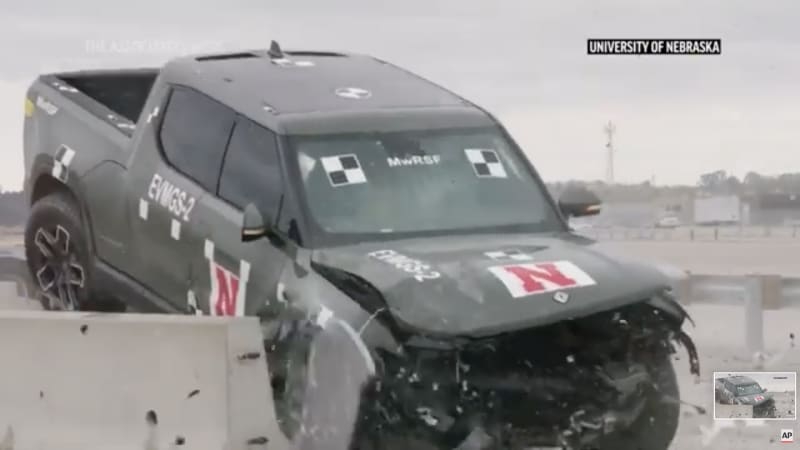Crash tests indicate EVs and other heavy vehicles are too much for highway guardrails

LINCOLN, Neb. — Under an overcast sky last fall, engineers with a University of Nebraska road safety facility watched as a electric-powered pickup truck hurtled toward a guardrail installed on the facility’s testing ground on the edge of the local municipal airport.
The test crash was to see how the guardrail — the same type found along tens of thousands of miles of roadway in the United States — would hold up against vehicles such as EVs, pickups and large SUVs that can weigh hundreds or thousands of pounds more than the average gas-powered sedan.
“We knew it was going to be an extremely demanding test of the roadside safety system,” said Cody Stolle with the university’s Midwest Roadside Safety Facility. “The system was not made to handle vehicles greater than 5,000 pounds.”
It came as little surprise when the nearly 4-ton 2022 Rivian R1T tore through the metal guardrail and hardly slowed until hitting a concrete barrier yards away on the other side.
The university released the results of the crash test Wednesday. The concern comes as the rising popularity of electric vehicles has led transportation officials to sound the alarm over vehicle weight disparity. Last year, the National Transportation Safety Board expressed concern about the safety risks heavy electric vehicles pose if they collide with lighter vehicles.
But Stolle’s team has seen this problem before — it’s a problem already with us on the roads. In the 1990s, as more people began buying pickups and sport utility vehicles, the Midwest Roadside Safety Facility found that the then-50-year-old guardrail system was proving inadequate to handle their extra weight.
“At the time, lightweight pickups made up 10-to-15% of the vehicle fleet,” Stolle said. “Now, more than 50% of vehicles on the road are pickups and SUVs.”
And many, if not most, full-size and heavy-duty pickups and SUVs already on the road exceed the 5,000-pound capacity of guardrails.
Road safety officials and organizations say electric vehicles themselves appear to offer superior protection to their occupants, even if they, like other heavy vehicles, might prove dangerous to occupants of lighter vehicles in a crash. The Rivian truck tested in Nebraska showed almost no damage to the cab’s interior after slamming into the concrete barrier, Stolle said.
But the entire purpose of guardrails is to help keep passenger vehicles from leaving the roadway, said Michael Brooks, executive director of the nonprofit Center for Auto Safety. Guardrails are intended to keep cars from careening off the road at critical areas, such as over bridges and waterways, near the edges of cliffs and ravines and over rocky terrain, where injury and death in an off-the-road crash is much more likely.
“Guardrails are kind of a safety feature of last resort,” Brooks said. “I think what you’re seeing here is the real concern with EVs — their weight. There are a lot of new vehicles in this larger-size range coming out in that 7,000-pound range. And that’s a concern.”
The preliminary crash test sponsored by the U.S. Army Corps of Engineers’ Research and Development Center also crashed a Tesla sedan into a guardrail, in which the sedan lifted the guardrail and passed under it. That said, a Tesla Model S weighs well under the 5,000-pound limit cited by Stolle, which calls those results into question.
The extra weight of electric vehicles comes from their outsized batteries needed to achieve a travel range of about 300 miles (480 kilometers) per charge. The batteries themselves can weigh almost as much as a small gas-powered car. Electric vehicles typically weigh 20% to 50% more than gas-powered vehicles and have lower centers of gravity.
“So far, we don’t see good vehicle to guardrail compatibility with electric vehicles,” Stolle said.
More testing, involving computer simulations and test crashes of more electric vehicles, is planned, he said, and will be needed to determine how to engineer roadside barriers that minimize the effects of crashes for both lighter gas-powered vehicles and heavier electric vehicles.
“Right now, electric vehicles are at or around 10% of new vehicles sold, so we have some time,” Stolle said. “But as EVs continue to be sold and become more popular, this will become a more prevalent problem. There is some urgency to address this.”
It’s impossible to know what more effective barriers will look like, Stolle said.
“It could be concrete barriers. It could be something else,” he said. “The scope of what we have to change and update still remains to be determined.”
The concern over the weight of electric vehicles stretches beyond vehicle-to-vehicle crashes and compatibility with guardrails, Brooks said. The extra weight will affect everything from faster wear on residential streets and driveways to vehicle tires and infrastructure like parking garages.
“A lot of these parking structures were built to hold vehicles that weighed 2,000 to 4,000 pounds — not 10,000 pounds,” he said.
“What really needs to happen is more collaboration between transportation engineers and vehicle manufacturers,” Brooks said. “That’s where you might might see some real change.”



